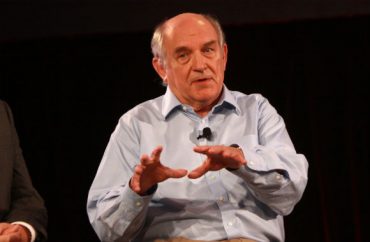Cornell University psychology professors Wendy Williams and Stephen Ceci have teamed up to pen a lengthy research paper on the troubling issues facing free speech rights on campuses today.
“Who Decides What Is Acceptable Speech on Campus? Why Restricting Free Speech Is Not the Answer,” published in May in Perspectives on Psychological Science, largely criticizes the suppression of free speech rights on campuses done in the name of left-wing inclusion and tolerance. In particular, the authors take on protestors’ arguments that violence is “justified by a higher moral responsibility to prevent marginalized groups from being victimized by hate speech.”
The article debunks the wrongly held belief by most college students that hate speech is not protected under the First Amendment by citing various legal precedents. The professors explain why mostly left-leaning mobs are so blind to reasonable debate, citing psychological hindrances such as “selective perception, confirmation bias, myside bias, illusion of understanding, blind-spot bias, groupthink/in-group bias, motivated skepticism, and naive realism.”
And they offer suggestions to help solve the problem of angry campus mobs shutting down speeches and advancing speaker disinvitations. For example, the professors suggest training students on free speech rights and debate tactics (in which they have to defend both sides of a controversial issue) during freshman orientation to help students understand how to cope with and address ideas with which they disagree, or even deem hate speech.
The lengthy and heavily cited article is many things at once, but hidden within the piece is a telling anecdote that illustrates the aggressive hoopla was not only misguided, but a disservice to scholarly debate.
 Most have heard of the incident involving conservative scholar Charles Murray at Middlebury College last year. Accused of being a racist and akin to Hitler, he was shouted down as he attempted to deliver a lecture about the decline of the white working class due to a decrease in marriage, religion, jobs, and a rise in opioid abuse.
Most have heard of the incident involving conservative scholar Charles Murray at Middlebury College last year. Accused of being a racist and akin to Hitler, he was shouted down as he attempted to deliver a lecture about the decline of the white working class due to a decrease in marriage, religion, jobs, and a rise in opioid abuse.
The protest forced him to livestream his address from a separate room. Demonstrators continued to bang on the wall and set off the fire alarm to interrupt his talk. As Murray attempted to leave, the mob met him at his car, and a scholar accompanying Murray was treated for a concussion and whiplash from the melee.
But was Murray’s talk “hate speech” worthy of such an aggressive coup? Williams and Ceci have proven it was not. They sent a transcript of Murray’s Middlebury speech, or the 14 minutes or so he was able to give via livestream before disruptions became too intense, to dozens of peers — but did not tell these scholars it was uttered by Murray.
And guess what? Their peers shrugged at the talk, calling it centrist and apolitical:
We sent this transcript to 68 faculty members in the United States and Canada. … We did not tell these faculty that the transcription was a talk by Murray nor that it was connected to the disturbance at Middlebury College. We asked them to rate it on a 9-point scale (1 = strongly liberal, 5 = middle-of-the-road, 9 = strongly conservative). Fifty-seven of the 68 faculty members responded (plus two spouses, one of whom we included because she is also a professor). Their median rating of Murray’s talk was 5 (mean = 5.02, SD = 1.34). The most liberal rating was 2.5, and the most conservative rating was 8; of the 58 faculty ratings, 37 were between 4 and 6, or middle of the road. Thus, faculty in this convenience sample did not view Murray’s comments as dangerously conservative, and none of their written comments suggested anything remotely oriented toward hate speech.
… Of the 58 faculty members who were unaware that the talk was by Murray, 26 accompanied their ratings with comments. They frequently viewed the talk as a list of descriptive facts that were neither controversial nor conservative but mainly centrist or liberal:
“I see it as mostly apolitical (apart from a couple of opinionated words). I would rate it a 5”;
“If the author is taking an ideological position, I can’t see it. I see nothing pro/anti rich/capitalism, there is no ‘signaling’ that I can see. And the person does not even take a stand on whether the development described is good, bad, or some mix. It’s just descriptive of a social phenomenon”;
“I’d have to say 5 non-partisan. He or she is not talking politics or policy”;
“5. It seems more a series of observations than a political statement of any kind”;
“Mostly just using data to make a set of observations. 5”;
“A 5. It is more or less a recitation of well-known trends in education and the economy; nothing very controversial there”;
“I give it a 4. Mostly because I associate the topic with liberals. But the passage is rather descriptive. I don’t see an action agenda that could be more revealing.”
When Williams and Ceci conducted their experiment using a different set of peers — this time telling fellow scholars the transcript came from Murray — many, but not all, found it right-of-center. And a group of random nonacademics found it centrist.
We also asked another group of 68 faculty to do the same rating, with one difference: We told them the text was from a speech by Charles Murray. This information made a statistical difference. The 44 who responded knowing it was written by Murray rated it as more conservative than did their blinded counterparts (M = 5.74, SD = 1.21), two-tailed t(96) = 2.74, p = .007. However, even this group’s mean was close to middle of the road. In sum, neither faculty group saw anything about Murray’s talk that deserved to be banned.
… In light of social psychologists’ liberal tendency, it was of interest to determine how a nonacademic sample would view Murray’s talk. Would they share the faculty belief that it was middle-of-the-road? To find out, we paid 200 Amazon Mechanical Turk workers (mean age = 32 years) to do the rating. They rated their own political orientation on the 9-point scale, and the mean was 4.22, slightly to the liberal side of the scale. To insure they carefully read the transcript of Murray’s talk, we included two factual questions related to the talk at the end of the MTurk survey that they had to answer correctly. Their mean rating of the Murray text was 5.22 (SD 1.17), which is squarely centrist. Thus, all three groups of adults rated the Murray talk as centrist, ranging from 5.02 to 5.74 on a 9-point scale.
What’s the takeaway? Here’s how Williams and Ceci sum it up:
This underscores the point made by over a hundred Middlebury faculty in their statement of principles … No group of professors or students has the right to act as final arbiter of the opinions that students may entertain. No group of professors or students has the right to determine for the entire community that a question is closed for discussion. Before protestors presume it is their prerogative or even their obligation to prevent classmates from hearing someone speak (legal scholars do not consider the use of speech to disrupt a speaker as protected speech; otherwise, all speakers would be susceptible to a “heckler’s veto”), they should imagine how it would feel if classmates exercised the same option and prevented them from hearing a controversial speaker from their side of the political aisle.
MORE: Middlebury hands down sanctions for Murray speech disruption
IMAGE: Gage Skidmore
Like The College Fix on Facebook / Follow us on Twitter




Add to the Discussion